Volume-Based Occupancy Detection for In-Cabin Applications by Millimeter Wave Radar
Abstract
:1. Introduction
- Volume-based occupancy detection: We introduce a method that leverages the variance of detected points within a point cloud to determine the volume of occupancy. This approach is less dependent on the range of targets from the radar, thereby reducing the need for separate databases for each seat.
- Robustness to multipath reflections: Our proposed method demonstrates greater robustness to multipath reflections compared to traditional energy-based methods. This improvement is particularly evident when the front seats are occupied by adults, where energy-based methods typically struggle.
- Simplified classification labels: We utilize only three classification labels—adult, baby, and empty—to streamline the detection process. This simplification enhances the efficiency and accuracy of the classification.
- Feature selection optimization: We explore various feature selection methods to enhance the classification performance further, ensuring the most relevant features are utilized for accurate occupancy detection.
2. Methodology
2.1. FMCW Radar Fundamentals
2.2. Signal Design
2.3. Signal Processing Fundamentals for the Point Cloud Detection
2.3.1. Beat Signal in FMCW Radar
2.3.2. Clutter Removal
2.3.3. Capon Beamforming
2.3.4. Constant False Alarm Rate (CFAR)
2.4. Occupancy Detection Approaches
2.5. Classification
- Identify minority class instances: SMOTE identifies the minority class instances in the dataset. These are the instances that are under-represented compared to the majority class.
- Select k-nearest neighbors: For each minority class instance, SMOTE selects k-nearest neighbors from the same class. The value of k is typically set to 5, but it can be adjusted based on the dataset.
- Generate synthetic samples: SMOTE generates synthetic samples by interpolating between the selected minority instance and its k-nearest neighbors. The synthetic sample is created by randomly choosing a point along the line segment connecting the minority instance and one of its neighbors.
2.5.1. Feature Explanation and Superiority
- Minimum and maximum: These features capture the range of values in the dataset, providing insights into the extremities of the detected points.
- Mean: The average value helps in understanding the central tendency of the data.
- Skewness and kurtosis: These statistical measures describe the distribution shape, revealing asymmetry and the presence of outliers.
- Median: As a robust measure of central tendency, the median is less affected by outliers.
- Entropy: This measure indicates the randomness or unpredictability in the dataset, providing a sense of the data complexity.
- Shape factor and impulse factor: These features are specifically chosen to capture the geometric and structural characteristics of the detected point cloud, which are crucial for accurate volume-based occupancy detection.
2.5.2. Feature Selection Methods
- Suitability for low dimensional data: This approach is computationally faster than wrapper and embedded methods.
- Algorithm independence: It is almost independent of the learning algorithm, allowing its use with various learning algorithms.
3. Experimental Studies
3.1. Experimental Setup
3.2. Results and Discussion
4. Conclusions
Author Contributions
Funding
Data Availability Statement
Acknowledgments
Conflicts of Interest
References
- Lichtinger, H.; Curtis, B.M.; Graf, R.; Reich, D.; Morrell, S.; Kremer, M. Sensor Assembly for Seat Occupant Weight Classification System. US Patent 7503417B2, 17 March 2009. [Google Scholar]
- Breed, D.S.; DuVall, W.E.; Johnson, W.C. Dynamic Weight Sensing and Classification of Vehicular Occupants. US Patent 7620521B2, 17 November 2009. [Google Scholar]
- Yang, J.; Santamouris, M.; Lee, S.E. Review of Occupancy Sensing Systems and Occupancy Modeling Methodologies for the Application in Institutional Buildings. Energy Build. 2016, 121, 344–349. [Google Scholar] [CrossRef]
- Hou, Y.-L.; Pang, G.K.H. People Counting and Human Detection in a Challenging Situation. IEEE Trans. Syst. Man Cybern. Part A Syst. Hum. 2011, 41, 24–33. [Google Scholar] [CrossRef]
- Tang, N.C.; Lin, Y.-Y.; Weng, M.-F.; Liao, H.-Y.M. Cross-Camera Knowledge Transfer for Multiview People Counting. IEEE Trans. Image Process. 2015, 24, 80–93. [Google Scholar] [CrossRef]
- Siddiqui, H.U.R.; Saleem, A.A.; Brown, R.; Bademci, B.; Lee, E.; Rustam, F.; Dudley, S. Non-Invasive Driver Drowsiness Detection System. Sensors 2021, 21, 4833. [Google Scholar] [CrossRef]
- Staszek, K.; Wincza, K.; Gruszczynski, S. Driver’s Drowsiness Monitoring System Utilizing Microwave Doppler Sensor. In Proceedings of the 2012 19th International Conference on Microwaves, Radar & Wireless Communications, Warsaw, Poland, 21–23 May 2012; Volume 2, pp. 623–626. [Google Scholar]
- Ciattaglia, G.; Spinsante, S.; Gambi, E. Slow-Time MmWave Radar Vibrometry for Drowsiness Detection. In Proceedings of the 2021 IEEE International Workshop on Metrology for Automotive (MetroAutomotive), Virtual Conference, 1–2 July 2021; pp. 141–146. [Google Scholar]
- Hyundai Inc. Available online: https://www.tu-auto.com/hyundais-radar-to-protect-forgotten-kids/ (accessed on 28 October 2022).
- Toyota Inc. Available online: https://blog.vayyar.com/vayyar-sensor-for-toyota-cabin-awareness (accessed on 6 November 2022).
- Yang, Z.; Bocca, M.; Jain, V.; Mohapatra, P. Contactless Breathing Rate Monitoring in Vehicle Using UWB Radar. In Proceedings of the 7th International Workshop on Real-World Embedded Wireless Systems and Networks, Shenzhen, China, 4 November 2018; Association for Computing Machinery: New York, NY, USA, 2018; pp. 13–18. [Google Scholar]
- Vinci, G.; Lenhard, T.; Will, C.; Koelpin, A. Microwave Interferometer Radar-Based Vital Sign Detection for Driver Monitoring Syst. In Proceedings of the 2015 IEEE MTT-S International Conference on Microwaves for Intelligent Mobility (ICMIM), Heidelberg, Germany, 27–29 April 2015; pp. 1–4. [Google Scholar]
- Wang, F.; Zeng, X.; Wu, C.; Wang, B.; Liu, K.J.R. Driver Vital Signs Monitoring Using Millimeter Wave Radio. IEEE Internet Things J. 2022, 9, 11283–11298. [Google Scholar] [CrossRef]
- Gharamohammadi, A.; Pirani, M.; Khajepour, A.; Shaker, G. Multibin Breathing Pattern Estimation by Radar Fusion for Enhanced Driver Monitoring. IEEE Trans. Instrum. Meas. 2024, 73, 1–12. [Google Scholar] [CrossRef]
- Gharamohammadi, A.; Khajepour, A.; Shaker, G. In-Vehicle Monitoring by Radar: A Review. IEEE Sens. J. 2023, 1, 25650–25672. [Google Scholar] [CrossRef]
- Zhang, X.; Wu, Q.; Zhao, D. Dynamic Hand Gesture Recognition Using FMCW Radar Sensor for Driving Assistance. In Proceedings of the 2018 10th International Conference on Wireless Communications and Signal Processing (WCSP), Hangzhou, China, 18–20 October 2018; pp. 1–6. [Google Scholar]
- Smith, K.A.; Csech, C.; Murdoch, D.; Shaker, G. Gesture Recognition Using Mm-Wave Sensor for Human-Car Interface. IEEE Sens. Lett. 2018, 2, 1–4. [Google Scholar] [CrossRef]
- Wang, X.; Bai, J.; Zhu, X.; Huang, L.; Xiong, M. Research on Gesture Recognition Algorithm Based on Millimeter-Wave Radar in Vehicle Scene; SAE Technical Paper; SAE: Warrendale, PA, USA, 2022. [Google Scholar]
- Li, G.; Zhang, S.; Fioranelli, F.; Griffiths, H. Effect of Sparsity-Aware Time–Frequency Analysis on Dynamic Hand Gesture Classification with Radar Micro-Doppler Signatures. IET Radar Sonar Navig. 2018, 12, 815–820. [Google Scholar] [CrossRef]
- Molchanov, P.; Gupta, S.; Kim, K.; Pulli, K. Multi-Sensor System for Driver’s Hand-Gesture Recognition. In Proceedings of the 2015 11th IEEE International Conference and Workshops on Automatic Face and Gesture Recognition (FG), Ljubljana, Slovenia, 4–8 May 2015; Volume 1, pp. 1–8. [Google Scholar]
- Molchanov, P.; Gupta, S.; Kim, K.; Pulli, K. Short-Range FMCW Monopulse Radar for Hand-Gesture Sensing. In Proceedings of the 2015 IEEE Radar Conference (RadarCon), Arlington, VA, USA, 10–15 May 2015; pp. 1491–1496. [Google Scholar]
- Khan, F.; Leem, S.K.; Cho, S.H. Hand-Based Gesture Recognition for Vehicular Applications Using IR-UWB Radar. Sensors 2017, 17, 833. [Google Scholar] [CrossRef] [PubMed]
- Khan, F.; Cho, S.H. Hand Based Gesture Recognition inside a Car through IR-UWB Radar. Korean Soc. Electron. Eng. 2017, 154–157. [Google Scholar]
- Gharamohammadi, A.; Shaker, G. A Novel Back-Projection Algorithm Improved by Antenna Pattern Automatized by 2-D CFAR. In Proceedings of the 2022 IEEE International Symposium on Antennas and Propagation and USNC-URSI Radio Science Meeting (AP-S/URSI), Denver, CO, USA, 10–15 July 2022; pp. 1158–1159. [Google Scholar]
- Gharamohammadi, A.; Shokouhmand, A. A Robust Whitening Algorithm to Identify Buried Objects with Similar Attributes in Correlation-Based Detection. J. Appl. Geophy. 2020, 172, 103917. [Google Scholar] [CrossRef]
- Gharamohammadi, A.; Norouzi, Y.; Aghaeinia, H. Optimized UWB Signal to Shallow Buried Object Imaging. Prog. Electromagn. Res. Lett. 2018, 72, 7–10. [Google Scholar] [CrossRef]
- Gharamohammadi, A.; Behnia, F.; Amiri, R. Imaging Based on Correlation Function for Buried Objects Identification. IEEE Sens. J. 2018, 18, 7407–7413. [Google Scholar] [CrossRef]
- Gharamohammadi, A.; Behnia, F.; Shokouhmand, A.; Shaker, G. Robust Wiener Filter-Based Time Gating Method for Detection of Shallowly Buried Objects. IET Signal Process. 2021, 15, 28–39. [Google Scholar] [CrossRef]
- Gharamohammadi, A.; Behnia, F.; Shokouhmand, A. Imaging Based on a Fast Back-Projection Algorithm Considering Antenna Beamwidth. In Proceedings of the 2019 6th Iranian Conference on Radar and Surveillance Systems, ICRSS 2019, Isfahan, Iran, 4–6 December 2019. [Google Scholar]
- Gharamohammadi, A.; Behnia, F.; Shokouhmand, A. Machine Learning Based Identification of Buried Objects Using Sparse Whitened NMF. arXiv 2019, arXiv:1910.07180. [Google Scholar]
- Möderl, J.; Posch, S.; Pernkopf, F.; Witrisal, K. “ UWBCarGraz” Dataset for Car Occupancy Detection Using Ultra-Wideband Radar. arXiv 2023, arXiv:2311.10478. [Google Scholar]
- Choi, J.W.; Yim, D.H.; Cho, S.H. People Counting Based on an IR-UWB Radar Sensor. IEEE Sens. J. 2017, 17, 5717–5727. [Google Scholar] [CrossRef]
- Nezirovic, A.; Yarovoy, A.G.; Ligthart, L.P. Signal Processing for Improved Detection of Trapped Victims Using UWB Radar. IEEE Trans. Geosci. Remote Sens. 2010, 48, 2005–2014. [Google Scholar] [CrossRef]
- Abu-Sardanah, S.; Gharamohammadi, A.; Ramahi, O.M.; Shaker, G. A Wearable Mm-Wave Radar Platform for Cardiorespiratory Monitoring. IEEE Sens. Lett. 2023, 7, 1–4. [Google Scholar] [CrossRef]
- Maaref, N.; Millot, P.; Pichot, C.; Picon, O. A Study of UWB FM-CW Radar for the Detection of Human Beings in Motion Inside a Building. IEEE Trans. Geosci. Remote Sens. 2009, 47, 1297–1300. [Google Scholar] [CrossRef]
- Hunt, A.R. Use of a Frequency-Hopping Radar for Imaging and Motion Detection Through Walls. IEEE Trans. Geosci. Remote Sens. 2009, 47, 1402–1408. [Google Scholar] [CrossRef]
- Hamidi, S.; Naeini, S.S.; Shaker, G. An Overview of Vital Signs Monitoring Based on RADAR Technologies. In Sensing Technology; Suryadevara, N.K., George, B., Jayasundera, K.P., Roy, J.K., Mukhopadhyay, S.C., Eds.; Springer International Publishing: Cham, Switzerland, 2022; pp. 113–124. [Google Scholar]
- Hashim, N.M.Z.; Basri, H.; Jaafar, A.; Aziz, M.A.; Salleh, A.; Ja’afar, A.S. Child in Car Alarm System Using Various Sensors. ARPN J. Eng. Appl. Sci. 2014, 9. [Google Scholar]
- Sterner, H.; Aichholzer, W.; Haselberger, M. Development of an Antenna Sensor for Occupant Detection in Passenger Transportation. Procedia Eng. 2012, 47, 178–183. [Google Scholar] [CrossRef]
- Mousel, T.; Larsen, P.; Lorenz, H. Unattended Children in Cars: Radiofrequency-Based Detection to Reduce Heat Stroke Fatalities. In Proceedings of the 25th International Technical Conference on the Enhanced Safety of Vehicles (ESV): Innovations in Vehicle Safety: Opportunities and Challenges, Detroit, MI, USA, 5–8 June 2017. [Google Scholar]
- Diewald, A.R.; Landwehr, J.; Tatarinov, D.; di Mario Cola, P.; Watgen, C.; Mica, C.; Lu-Dac, M.; Larsen, P.; Gomez, O.; Goniva, T. RF-Based Child Occupation Detection in the Vehicle Interior. In Proceedings of the 2016 17th International Radar Symposium (IRS), Krakow, Poland, 10–12 May 2016; pp. 1–4. [Google Scholar]
- Caddemi, A.; Cardillo, E. Automotive Anti-Abandon Systems: A Millimeter-Wave Radar Sensor for the Detection of Child Presence. In Proceedings of the 2019 14th International Conference on Advanced Technologies, Systems and Services in Telecommunications (TELSIKS), Nis, Serbia, 23–25 October 2019; pp. 94–97. [Google Scholar]
- Diewald, A.R.; Fox, A.; Tatarinov, D. Thorough Analysis of Multipath Propagation Effects for Radar Applications in the Vehicle Interior. In Proceedings of the 2018 11th German Microwave Conference (GeMiC), Freiburg, Germany, 12–14 March 2018; pp. 63–66. [Google Scholar]
- Abedi, H.; Magnier, C.; Mazumdar, V.; Shaker, G. Improving Passenger Safety in Cars Using Novel Radar Signal Processing. Eng. Rep. 2021, 3, e12413. [Google Scholar] [CrossRef]
- Diewald, A.R.; Tatarinov, D. Non-Broadside Patch Antenna for Car-Interior Passenger Detection. In Proceedings of the 2017 18th International Radar Symposium (IRS), Prague, Czech Republic, 28–30 June 2017; pp. 1–10. [Google Scholar]
- Peng, W.; Li, H.; Tang, J.; Lin, L.; Teng, Z.; Luo, C.; Zhu, L.; Zhu, Z. Safety Protection System Computer Aided Design in Enclosed Vehicle Using Film Pressure Sensor and Microwave Radar. In Proceedings of the 2021 IEEE International Conference on Data Science and Computer Application (ICDSCA), Dalian, China, 28–30 October 2021; pp. 553–555. [Google Scholar]
- Liao, J.; Xiang, G.; Cao, L.; Xia, J.; Yue, L. The Left-behind Human Detection and Tracking System Based on Vision with Multi-Model Fusion and Microwave Radar inside the Bus. Proc. Inst. Mech. Eng. Part D J. Automob. Eng. 2020, 234, 2342–2354. [Google Scholar] [CrossRef]
- Abedi, H.; Magnier, C.; Shaker, G. Passenger Monitoring Using AI-Powered Radar. In Proceedings of the 2021 IEEE 19th International Symposium on Antenna Technology and Applied Electromagnetics (ANTEM), Winnipeg, MB, Canada, 8–11 August 2021; pp. 1–2. [Google Scholar]
- Lim, S.; Jung, J.; Kim, S.-C.; Lee, S. Deep Neural Network-Based In-Vehicle People Localization Using Ultra-Wideband Radar. IEEE Access 2020, 8, 96606–96612. [Google Scholar] [CrossRef]
- Alizadeh, M.; Abedi, H.; Shaker, G. Low-Cost Low-Power in-Vehicle Occupant Detection with Mm-Wave FMCW Radar. In Proceedings of the 2019 IEEE Sensors, Montreal, QC, Canada, 27–30 October 2019; pp. 1–4. [Google Scholar]
- Hyun, E.; Jin, Y.-S.; Park, J.-H.; Yang, J.-R. Machine Learning-Based Human Recognition Scheme Using a Doppler Radar Sensor for In-Vehicle Applications. Sensors 2020, 20, 202. [Google Scholar] [CrossRef] [PubMed]
- Abedi, H.; Luo, S.; Shaker, G. On the Use of Low-Cost Radars and Machine Learning for In-Vehicle Passenger Monitoring. In Proceedings of the 2020 IEEE 20th Topical Meeting on Silicon Monolithic Integrated Circuits in RF Systems (SiRF), San Antonio, TX, USA, 26–29 January 2020; pp. 63–65. [Google Scholar]
- Chen, Y.; Luo, Y.; Qi, A.; Miao, M.; Qi, Y. In-Cabin Monitoring Based on Millimeter Wave FMCW Radar. In Proceedings of the 2021 13th International Symposium on Antennas, Propagation and EM Theory (ISAPE), Zhuhai, China, 1–4 December 2021; Volume 1, pp. 1–3. [Google Scholar]
- Ma, Y.; Zeng, Y.; Jain, V. CarOSense: Car Occupancy Sensing with the Ultra-Wideband Keyless Infrastructure. Proc. ACM Interact. Mob. Wearable Ubiquitous Technol. 2020, 4, 1–28. [Google Scholar] [CrossRef]
- Abedi, H.; Luo, S.; Mazumdar, V.; Riad, M.M.Y.R.; Shaker, G. AI-Powered In-Vehicle Passenger Monitoring Using Low-Cost Mm-Wave Radar. IEEE Access 2022, 10, 18998–19012. [Google Scholar] [CrossRef]
- Song, H.; Shin, H.-C. Single-Channel FMCW-Radar-Based Multi-Passenger Occupancy Detection Inside Vehicle. Entropy 2021, 23, 1472. [Google Scholar] [CrossRef] [PubMed]
- Yang, X.; Ding, Y.; Zhang, X.; Zhang, L. Spatial-Temporal-Circulated GLCM and Physiological Features for In-Vehicle People Sensing Based on IR-UWB Radar. IEEE Trans. Instrum. Meas. 2022, 71, 1–13. [Google Scholar] [CrossRef]
- Lim, S.; Lee, S.; Jung, J.; Kim, S.-C. Detection and Localization of People Inside Vehicle Using Impulse Radio Ultra-Wideband Radar Sensor. IEEE Sens. J. 2020, 20, 3892–3901. [Google Scholar] [CrossRef]
- Song, H.; Yoo, Y.; Shin, H.-C. In-Vehicle Passenger Detection Using FMCW Radar. In Proceedings of the International Conference on Information Networking (ICOIN), Jeju Island, Republic of Korea, 13–16 January 2021; pp. 644–647. [Google Scholar]
- Preethi, P.; Mamatha, H.R. Region-Based Convolutional Neural Network for Segmenting Text in Epigraphical Images. Artif. Intell. Appl. 2022, 1, 119–127. [Google Scholar] [CrossRef]
- Deng, W.; Cai, X.; Wu, D.; Song, Y.; Chen, H.; Ran, X.; Zhou, X.; Zhao, H. MOQEA/D: Multi-Objective QEA With Decomposition Mechanism and Excellent Global Search and Its Application. IEEE Trans. Intell. Transp. Syst. 2024. [Google Scholar] [CrossRef]
- Bhosle, K.; Musande, V. Evaluation of Deep Learning CNN Model for Recognition of Devanagari Digit. Artif. Intell. Appl. 2023, 1, 114–118. [Google Scholar] [CrossRef]
- Akande, T.; Alabi, O.A.; Ajagbe, S.A. A Deep Learning-Based CAE Approach for Simulating 3D Vehicle Wheels Under Real-World Conditions. Artif. Intell. Appl. 2024. [Google Scholar] [CrossRef]
- Song, Y.; Han, L.; Zhang, B.; Deng, W. A Dual-Time Dual-Population Multi-Objective Evolutionary Algorithm with Application to the Portfolio Optimization Problem. Eng. Appl. Artif. Intell. 2024, 133, 108638. [Google Scholar] [CrossRef]
- Li, F.; Chen, J.; Zhou, L.; Kujala, P. Investigation of Ice Wedge Bearing Capacity Based on an Anisotropic Beam Analogy. Ocean Eng. 2024, 302, 117611. [Google Scholar] [CrossRef]
- Wu, H.; Prasad, S. Semi-Supervised Deep Learning Using Pseudo Labels for Hyperspectral Image Classification. IEEE Trans. Image Process. 2018, 27, 1259–1270. [Google Scholar] [CrossRef]
- Li, M.; Wang, Y.; Yang, C.; Lu, Z.; Chen, J. Automatic Diagnosis of Depression Based on Facial Expression Information and Deep Convolutional Neural Network. IEEE Trans. Comput. Soc. Syst. 2024, 1–12. [Google Scholar] [CrossRef]
- Servadei, L.; Sun, H.; Ott, J.; Stephan, M.; Hazra, S.; Stadelmayer, T.; Lopera, D.S.; Wille, R.; Santra, A. Label-Aware Ranked Loss for Robust People Counting Using Automotive In-Cabin Radar. In Proceedings of the ICASSP 2022, 2022 IEEE International Conference on Acoustics, Speech and Signal Processing (ICASSP), Singapore, 22–27 May 2022; pp. 3883–3887. [Google Scholar]
- Alizadeh, M.; Shaker, G.; De Almeida, J.C.M.; Morita, P.P.; Safavi-Naeini, S. Remote Monitoring of Human Vital Signs Using Mm-Wave FMCW Radar. IEEE Access 2019, 7, 54958–54968. [Google Scholar] [CrossRef]
- Texas Instruments Inc. Self-Calibration in TI’s MmWave Radar Devices. Available online: https://dev.ti.com/tirex/explore/node?node=A__ALN7lP07MD0wMIRRMa1bwA__RADAR-ACADEMY__GwxShWe__LATEST&search=calibration (accessed on 7 January 2024).
- Texas Instruments Inc. Vehicle Occupant Detection Reference Design. Available online: https://www.ti.com/lit/ug/tidue95a/tidue95a.pdf (accessed on 11 August 2022).
- Bagheri, M.O.; Gharamohammadi, A.; Abu-Sardanah, S.; Ramahi, O.M.; Shaker, G. Radar Near-Field Sensing Using Metasurface for Biomedical Applications. Commun. Eng. 2024, 3, 51. [Google Scholar] [CrossRef]
- Núñez-Ortuño, J.M.; González-Coma, J.P.; Nocelo López, R.; Troncoso-Pastoriza, F.; Álvarez-Hernández, M. Beamforming Techniques for Passive Radar: An Overview. Sensors 2023, 23, 3435. [Google Scholar] [CrossRef]
- Shokouhmand, A.; Eckstrom, S.; Gholami, B.; Tavassolian, N. Camera-Augmented Non-Contact Vital Sign Monitoring in Real Time. IEEE Sens J 2022, 22, 11965–11978. [Google Scholar] [CrossRef]
- Chawla, N.V.; Bowyer, K.W.; Hall, L.O.; Kegelmeyer, W.P. SMOTE: Synthetic Minority over-Sampling Technique. J. Artif. Intell. Res. 2002, 16, 321–357. [Google Scholar] [CrossRef]
- Venkatesh, B.; Anuradha, J. A Review of Feature Selection and Its Methods. Cybern. Inf. Technol. 2019, 19, 3. [Google Scholar] [CrossRef]
- Liu, Y.; Wang, Y.; Zhang, J. New Machine Learning Algorithm: Random Forest. Information Computing and Applications; Liu, B., Ma, M., Chang, J., Eds.; Springer: Berlin/Heidelberg, Germany, 2012; pp. 246–252. [Google Scholar]
- Kamel, H.; Abdulah, D.; Al-Tuwaijari, J.M. Cancer Classification Using Gaussian Naive Bayes Algorithm. In Proceedings of the 2019 International Engineering Conference (IEC), Erbil, Iraq, 23–25 June 2019; pp. 165–170. [Google Scholar]
- An, T.-K.; Kim, M.-H. A New Diverse AdaBoost Classifier. In Proceedings of the 2010 International Conference on Artificial Intelligence and Computational Intelligence, Sanya, China, 23–24 October 2010; Volume 1, pp. 359–363. [Google Scholar]
- Hatwell, J.; Gaber, M.M.; Atif Azad, R.M. Ada-WHIPS: Explaining AdaBoost Classification with Applications in the Health Sciences. BMC Med. Inform. Decis. Mak. 2020, 20, 250. [Google Scholar] [CrossRef]
- Sen, P.C.; Hajra, M.; Ghosh, M. Supervised Classification Algorithms in Machine Learning: A Survey and Review. In Emerging Technology in Modelling and Graphics; Mandal, J.K., Bhattacharya, D., Eds.; Springer Singapore: Singapore, 2020; pp. 99–111. [Google Scholar]
- Bella Rose Baby Doll. Available online: https://www.bradfordexchange.ca/products/117759001_lifelike-breathing-baby-doll.html (accessed on 28 September 2023).
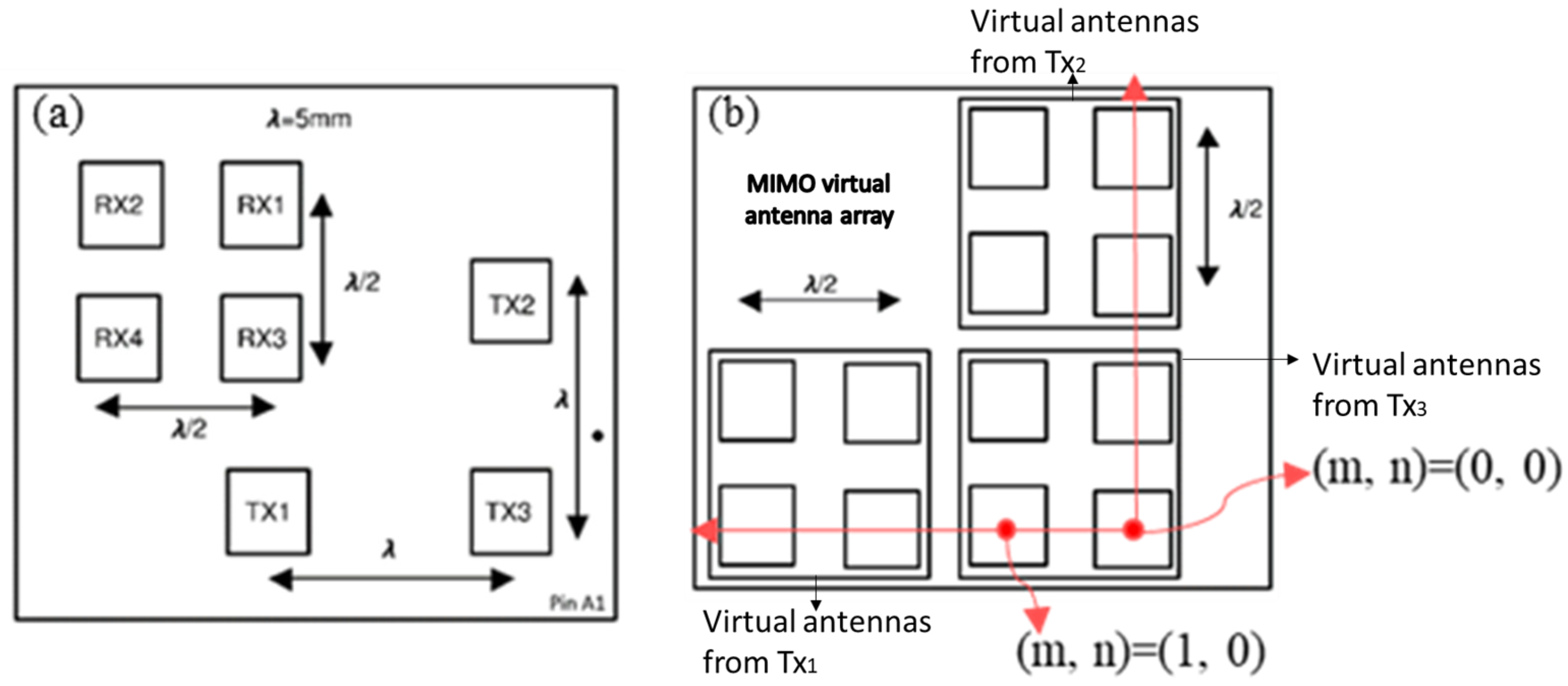

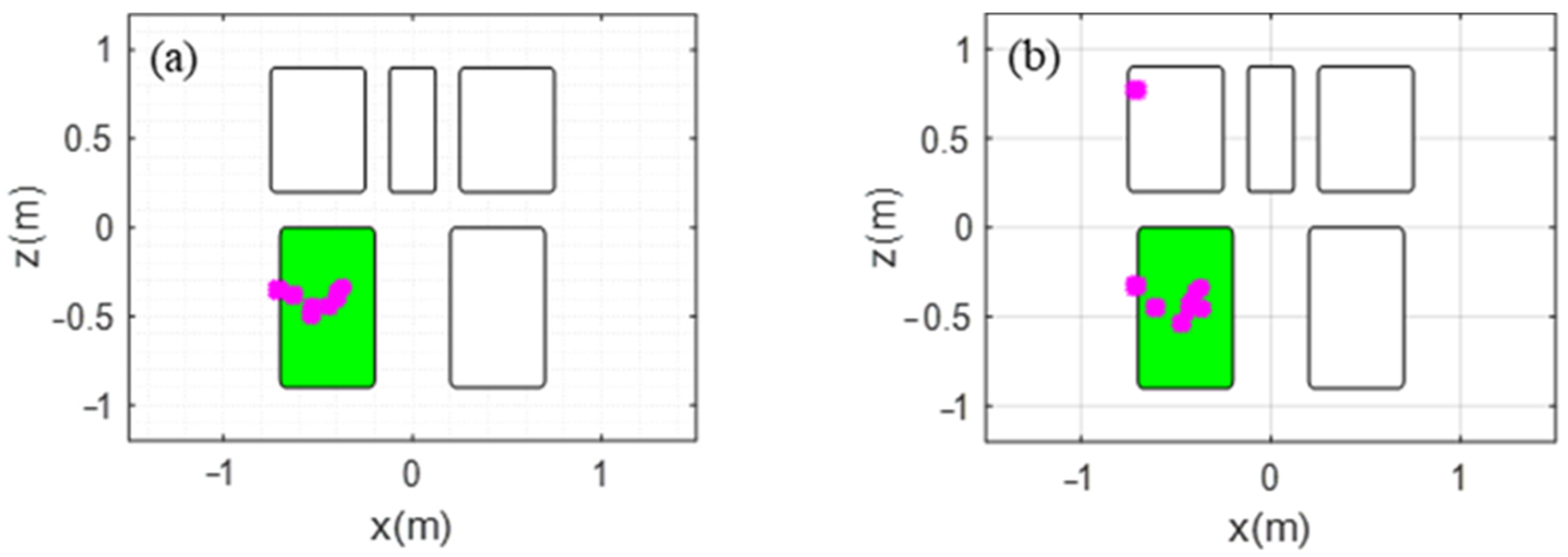
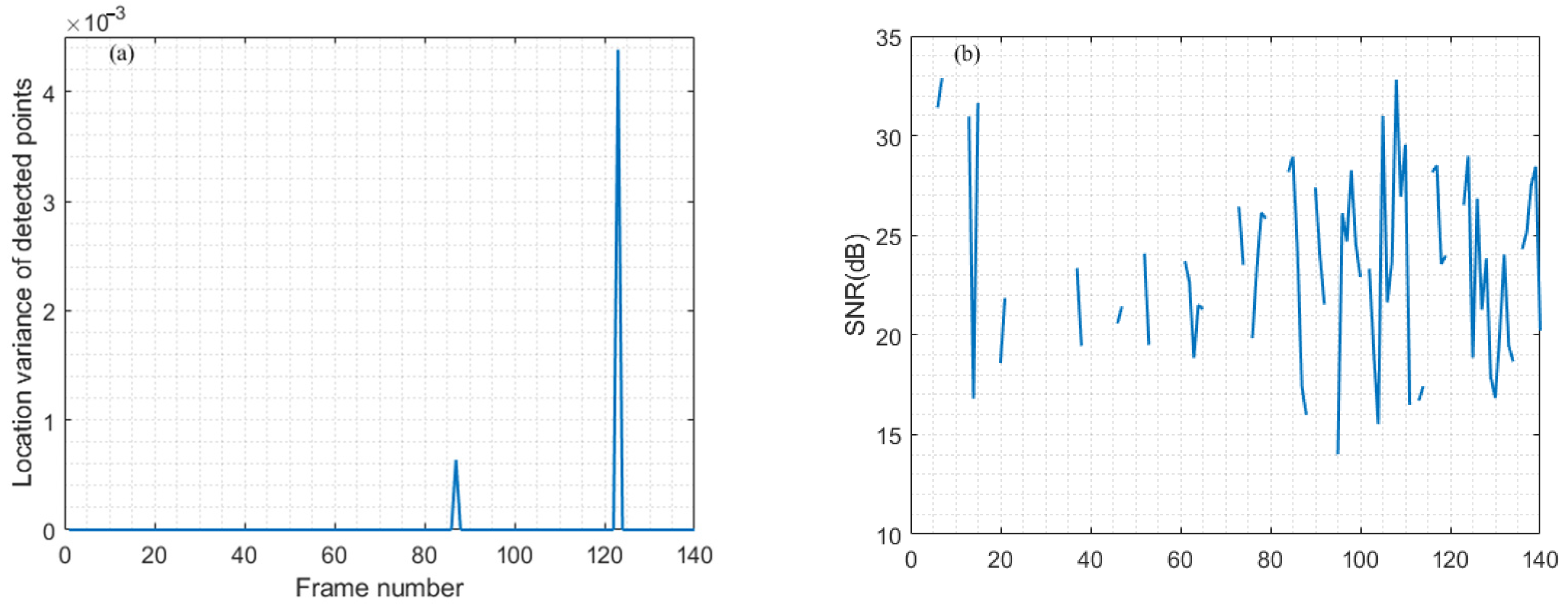
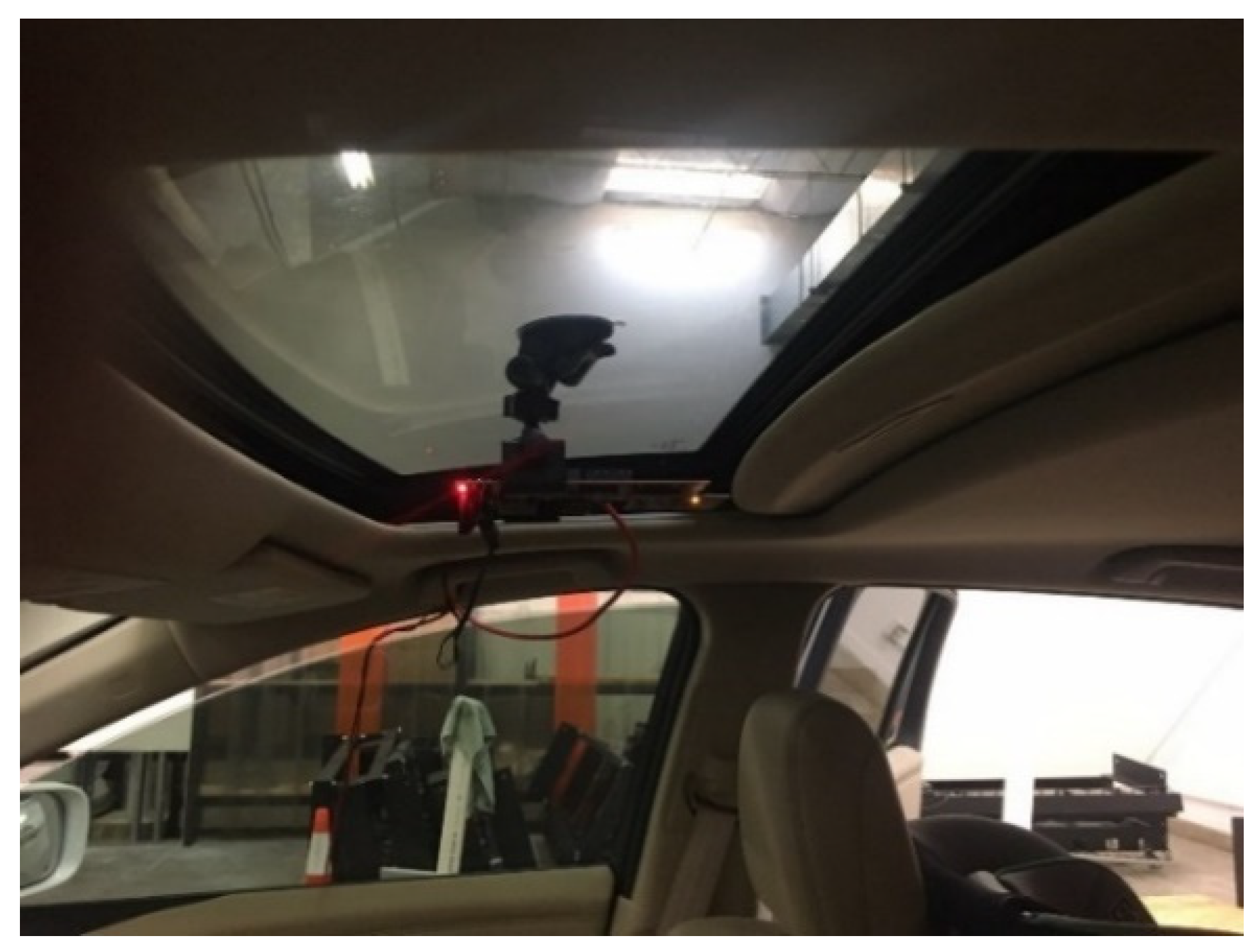
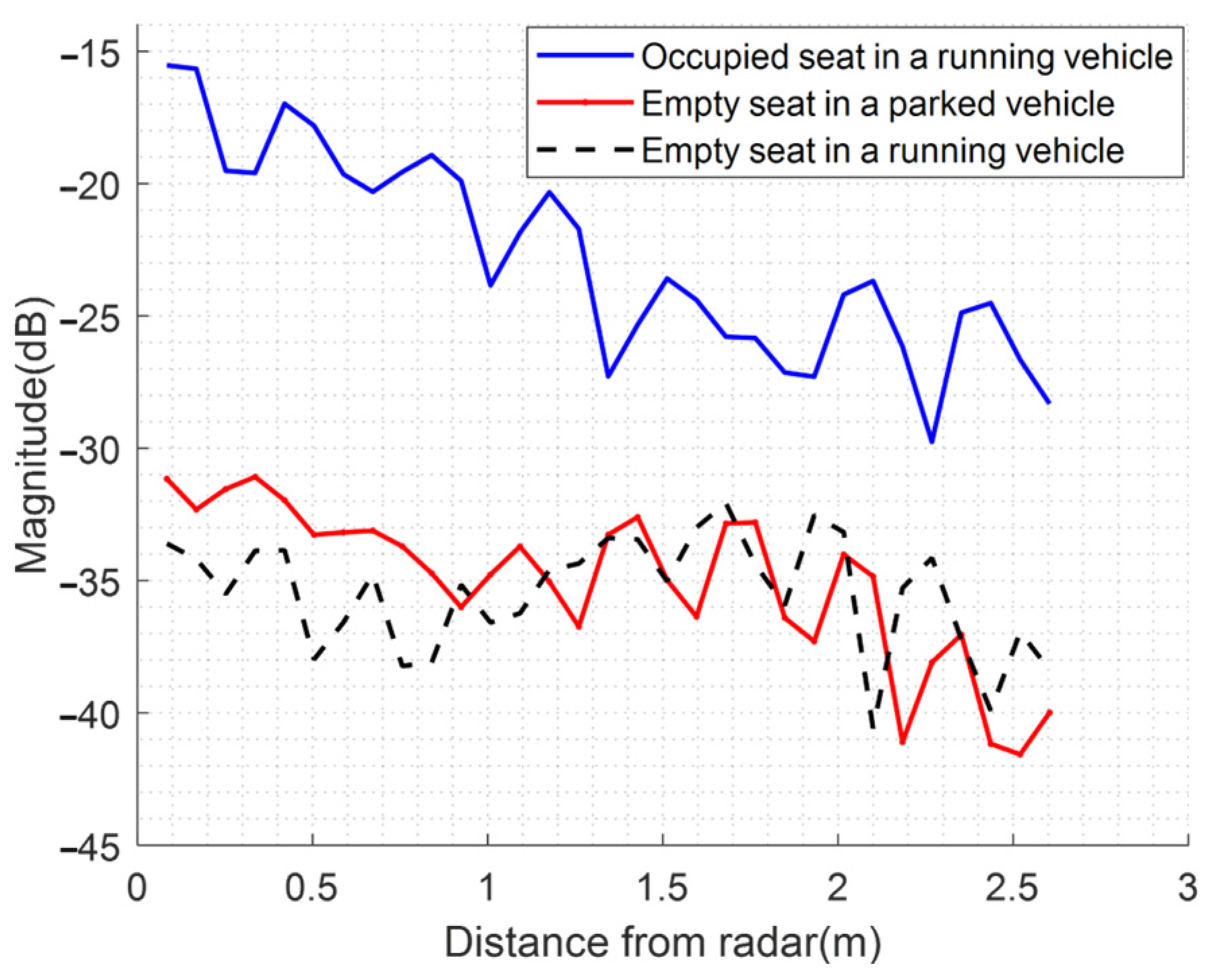
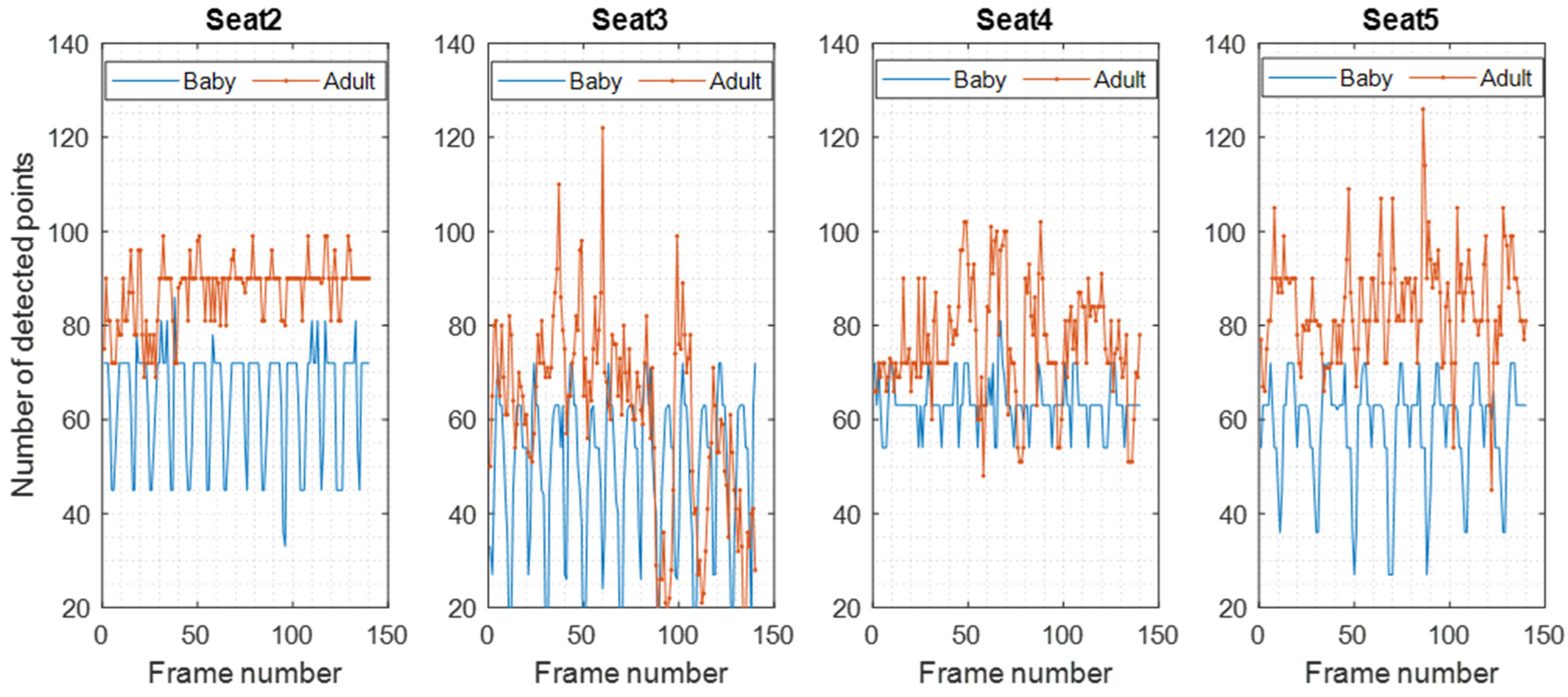
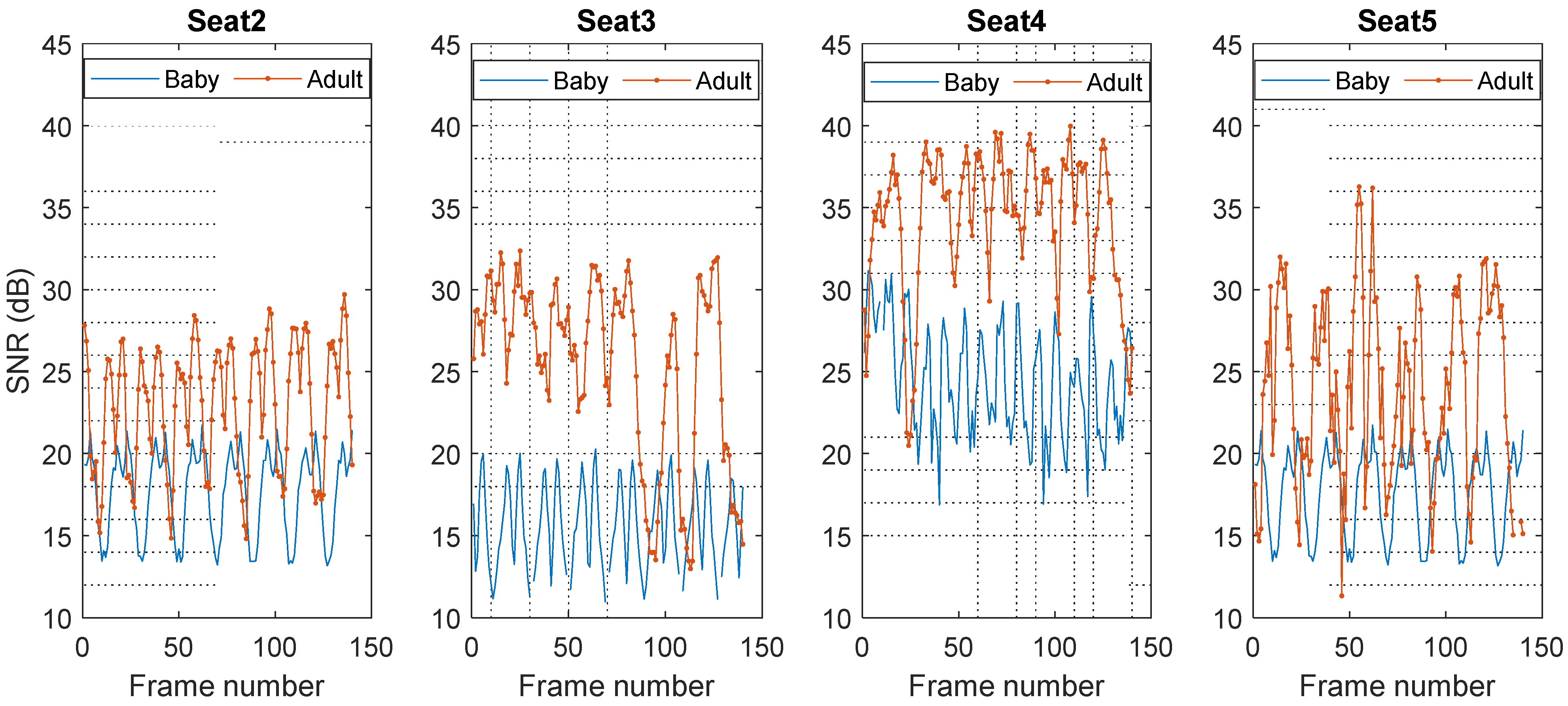

| Parameter | Configuration |
|---|---|
| Device | AWR6843AOP |
| Number of transmitters | 3 |
| Number of receivers | 4 |
| Field of view | 120° horizontal, 120° vertical |
| Maximum range | 2.7 m |
| Range resolution | 5.3 cm |
| Maximum velocity | 1.7 m/s |
| Velocity resolution | 1.5 cm/s |
| Frame periodicity | 200 ms |
| Technique | Score Function | Mode | Number of Features | Model | Missed Detection of Baby (%) | False Detection of Baby (%) | Precision (%) | Recall (%) | F1-Score (%) |
|---|---|---|---|---|---|---|---|---|---|
| Generic univariate feature selector | ANOVA F-value | False positive rate | 8 | RF | 4 | 1.1 | 98 | 96 | 97 |
| GNB | 4.9 | 1.1 | 97.5 | 95.5 | 96.5 | ||||
| ADB | 4.4 | 1.3 | 97.3 | 96 | 96.7 | ||||
| Generic univariate feature selector | Chi-squared | False positive rate | 7 | RF | 4.4 | 0.2 | 97.8 | 95.6 | 96.7 |
| GNB | 4.9 | 2.4 | 96.5 | 94.8 | 95.6 | ||||
| ADB | 5.3 | 0.2 | 97.2 | 94.7 | 95.9 | ||||
| Rank2D | algorithm = ‘covariance’ | 4 | RF | 1.8 | 1.5 | 98.5 | 98 | 98.2 | |
| GNB | 1.8 | 1.5 | 98.5 | 98 | 98.2 | ||||
| ADB | 1.8 | 0.2 | 98.8 | 98 | 98.4 | ||||
| SelectKBest | Mutual information | Number of features = 2 | 2 | RF | 2.7 | 2 | 98.2 | 97 | 97.6 |
| GNB | 1.8 | 4.2 | 97 | 98 | 97.5 | ||||
| ADB | 2.7 | 1.8 | 98.2 | 97 | 97.6 | ||||
| Generic univariate feature selector | ANOVA F-value | Percentile | 1 | RF | 6.2 | 2.2 | 97 | 94 | 95.5 |
| GNB | 4.9 | 5.6 | 94 | 95 | 94.5 | ||||
| ADB | 6.2 | 2.2 | 97 | 94 | 95.5 |
Disclaimer/Publisher’s Note: The statements, opinions and data contained in all publications are solely those of the individual author(s) and contributor(s) and not of MDPI and/or the editor(s). MDPI and/or the editor(s) disclaim responsibility for any injury to people or property resulting from any ideas, methods, instructions or products referred to in the content. |
© 2024 by the authors. Licensee MDPI, Basel, Switzerland. This article is an open access article distributed under the terms and conditions of the Creative Commons Attribution (CC BY) license (https://creativecommons.org/licenses/by/4.0/).
Share and Cite
Gharamohammadi, A.; Dabak, A.G.; Yang, Z.; Khajepour, A.; Shaker, G. Volume-Based Occupancy Detection for In-Cabin Applications by Millimeter Wave Radar. Remote Sens. 2024, 16, 3068. https://doi.org/10.3390/rs16163068
Gharamohammadi A, Dabak AG, Yang Z, Khajepour A, Shaker G. Volume-Based Occupancy Detection for In-Cabin Applications by Millimeter Wave Radar. Remote Sensing. 2024; 16(16):3068. https://doi.org/10.3390/rs16163068
Chicago/Turabian StyleGharamohammadi, Ali, Anand G. Dabak, Zigang Yang, Amir Khajepour, and George Shaker. 2024. "Volume-Based Occupancy Detection for In-Cabin Applications by Millimeter Wave Radar" Remote Sensing 16, no. 16: 3068. https://doi.org/10.3390/rs16163068
APA StyleGharamohammadi, A., Dabak, A. G., Yang, Z., Khajepour, A., & Shaker, G. (2024). Volume-Based Occupancy Detection for In-Cabin Applications by Millimeter Wave Radar. Remote Sensing, 16(16), 3068. https://doi.org/10.3390/rs16163068









